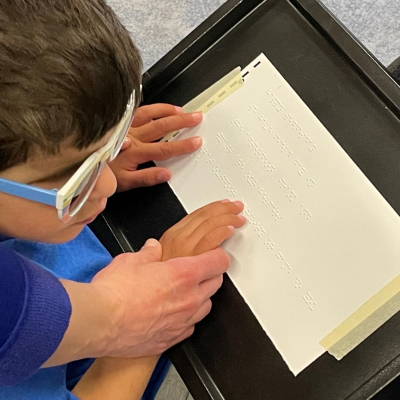
When asked to write about braille, my mind went in a lot of different directions. Should I give a brief history? Should I state the significance of its availability and describe the tremendous advances in technology made over the last few decades? I’ve decided to tackle what initially comes to mind.
What is braille?
Braille, for many, is the bumps in the elevator or on fast food cup lids. It is shrouded in mystery and sometimes awe, that anyone could possibly make sense of it. Basically, it is the tactile equivalent of print. Braille is not print in bas-belief, but another symbolic code which conveys thoughts and information the writer shares with the reader, similar to Chinese characters, hieroglyphics, and Latin and Arabic alphabets. Braille was created to make print information accessible to those who could not see print and to give the students the same educational opportunities as their peers. For those learning it, it can be many things. For some it is as natural as learning print is to a first grader, while to others who struggle between the print and tactile world, it can be tied to a lot of emotional issues, especially making children/teens not liking anything different from their peers. But, that goes beyond the scope of this blog.
When I was little, I became intrigued by braille when a missionary who was blind, stayed with us for a few days. She made a huge impression on me. She read braille, traveled, did public speaking, and even tried to teach me to knit! Her being right-handed and me being left, came with its own problems. I later read the books “Follow My Leader” and the Little House books in braille.
Accessibility
With the influx of new technology there are many options for people to access printed information easily. Even our cellphones can provide voice-over for texts. There are also audio books, scanners that take text to speech and museums with audio description of displays.
Importance of Braille
To me, there is something so personal about being able to read. Braille and print, if the person is able to interpret either set of symbols, gives the person freedom and independence. Technology is great but if it hits a glitch, gets outdated, the power is drained, or a variety of other problems that may arise, it no longer can function. However, even after a tornado hits and there are only bits of paper strewn on the ground, braille can still impart information. It is like a pencil; there is always a place for low tech and creativity. It’s important to have options toward being literate. Whether one reads it electronically or embossed, its personal. There are many day-to-day reasons braille promotes independence, for example, shopping lists, menus, ATMS, and room numbers in buildings. But I also think of the many things print readers treasure: reading a book while wrapped up in a blanket on a cold rainy day, reading a personal letter or love note, staying up past curfew reading under the covers* and savoring the feelings put upon the page all without the intrusion of an electronic voice or another person reading it aloud.
*This idea came from one of my former students. She kept Braille books under her pillow after ‘lights out’ and stayed up reading into the wee hours of the morning, then fell asleep in class! I’m a reading teacher, how can I fault her for that??
I’ve been teaching braille for a long time, but it still gives me goose bumps when a student reads a sentence for the first time. All the dots finally click, it’s priceless.
If you’re reading this, thank a braille teacher today! If you or someone you love is experiencing vision loss and could benefit from our services, please contact Future In Sight at [email protected] or 603-224-4039.
About the Author: Joann Moore is a Teacher of the Visually Impaired at Future In Sight.

